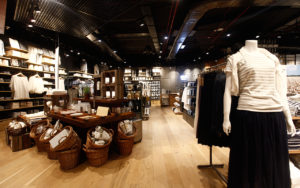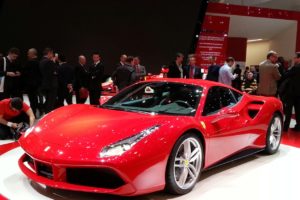It is absolute boom time for luxury retail in India. You could even call it embarrassment of the riches.
Japanese Brand Muji
In just the last two weeks, a range of stores have opened in the coastal city of Mumbai. First, Muji, the understated Japanese brand, which believes in being an ‘anti-brand’ (which means you won’t see its label anywhere on the product) made a quiet entry into Palladium Mall, the mixed-brands (some high street, some uber luxury) mall in Lower Parel, Mumbai.
Satoru Matsuzaki, the president, representative director and executive officer of Ryohin Keikaku Co. says, “We are not looking at India as a high-profit, high-market share destination for the next three to five years. We are going to look at India more from a mid- to long-term basis in product introduction, there are two directions of thinking—one is new development from scratch or bespoke. Another is Found MUJI, which is finding product ideas from everywhere in the world, including India, where we spend a lot of time in those markets trying to glean or collect product ideas for development, and introduce those as our standard regular offerings. These products are updated or repurposed, and we often work with the original artisan or designer, to better fit changing contemporary lifestyles, cultures and customs among different countries, and are reproduced at a reasonable price. For instance, we have introduced a steel bowl, which we found in India, for sale across the world. “
Right after Muji, H&M, the high street European brand, made a high-profile entry into Phoenix, the High Street avatar of the same mall, located within the same complex. The biggest store in the Phoenix Mills and Palladium courtyard, it opened to much bigger crowds that sprawled out even to the sidewalk. And now we hear that Anavila Mishra, the magician of handloom weaves and dreamy pastel saris, will open her standalone store in the glitzy suburb of Khar soon.

Longchamp Boutique
Just last month ago, chic European brand Longchamp had thrown open the doors of its flagship Indian store in New Delhi. The brand, famous for its leather handbags, luggage, shoes and other fashion accessories, owns more than 300 exclusive stores globally and retails from another 1,500 points of sales. It is also scouting for another location, this time in Mumbai. “Real estate costs are high and there is a dearth of quality real estate. We would like to take it slow with Delhi and Mumbai and we may look at other locations like Chennai and Bengaluru going forward. The brand is in the affordable luxury space and considering the footfalls, malls make more sense than high street,” says Radha Kapoor, founder and director of DOIT Retail Brands, which has brought down Longchamp.
Mumbai and Delhi continue to remain the hub of luxury brands. While Delhi accounts for 50 per cent of all luxury sales, Mumbai’s share is 30 per cent, with the rest taken up by other cities. In their incisive book In The Cult of the Luxury Brand: Inside Asia’s Love Affair with Luxury, writers Radha Chadha and Paul Husband identify the capital as the hub for Old Money. The book states how Mumbai loses out in the luxury stakes as it doesn’t have the advantage of a large consumer base from satellite towns.
It points out the further fragmentation of Mumbai luxury consumers based on purchasing trends: the north (near the airport) and the central part where most of the New Money lives, and the south (Nariman Point, Malabar Hill and Colaba) which accounts for the Old Money. Kapoor points out, “Delhi is the largest market so far but Mumbai has shown a faster growth over the past two years.”
Luxury Brands Returns
Ferrari
Slowly but surely, luxury brands that had exited Indian are returning. Two years after it left, Italian sports car maker Ferrari returned to India late last year to open two showrooms in Mumbai and Delhi. Maison Montblanc returned India, again late last year, 20 months after it left in the wake of disputes with erstwhile partner Entrack International. Maison Montblanc now has a 51:49 per cent joint venture with Titan Company. The plan is to have five boutiques in India by March including two that have opened in Mumbai and Delhi.
Menswear brands Alfred Dunhill and Alexander Amosu, besides luxury car maker Maserati and Italian fashion brand Salvatore Ferragamo are some of the global luxury brands looking at opening in India.
“Luxury products are witnessing the highest percentage of growth in sales. Due to the polarisation of income, people are willing to spend, and brands do not want to be left out,” said BS Nagesh, founder, TRRAIN. TRRAIN trains employees for the luxury retail sector. “The market is such that no luxury brand can afford to ignore India. The timing could be either now or a few years after,” said Mr Nagesh. The consumption pattern in India is showing a growing trend,” he adds.
The relaxation of FDI rules by the government in single-brand retail has had a direct impact on a host of high-end luxury brands, which for years had to rely on local Indian partners for setting up shop. Unfortunately, Nagesh says, not many marquee properties are available or are vacant at prime malls for retail stores.
To attract new aspirational customers, most luxury brands across segments have unveiled a series of affordable luxury products to achieve larger sales volume. This trend is seen in watches, handbags, footwear, accessories and designer wear. Players like LVMH Watch & Jewellery India Pvt Ltd, Genesis Luxury Fashion Pvt Ltd, Hermès India Ltd and Burberry India increased the number of offerings in the Indian market in with an emphasis on affordable luxury to encourage more consumers to indulge.
Clearly, the retail space in India will see some more exciting launches over the next few years, as India finally opens up to luxury brands and their enticing campaigns.




